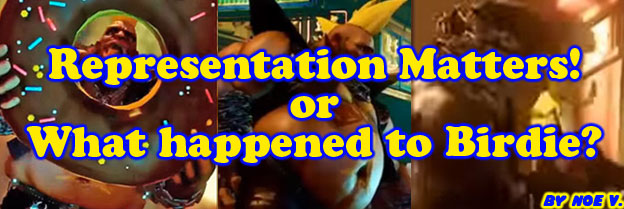
I'll get right to the punchline, fat characters were introduced into the recent crop of fighting games because they were funny to look at. For some reason Capcom producer Yoshinori Ono had decided to steer several characters into the absurd. When I saw what the team had done to Birdie in Street Fighter V I was deeply saddened. I thought to myself why would they do such a thing to such an original design. I could not think of a context where his transformation was justified. None of the other characters brought back had gotten fat. If the excuse was that punks got fat and lazy in their old age I would have to ague against that. Sure everybody may get out of shape as they get older but some in the punk rock community would argue that sentiment.
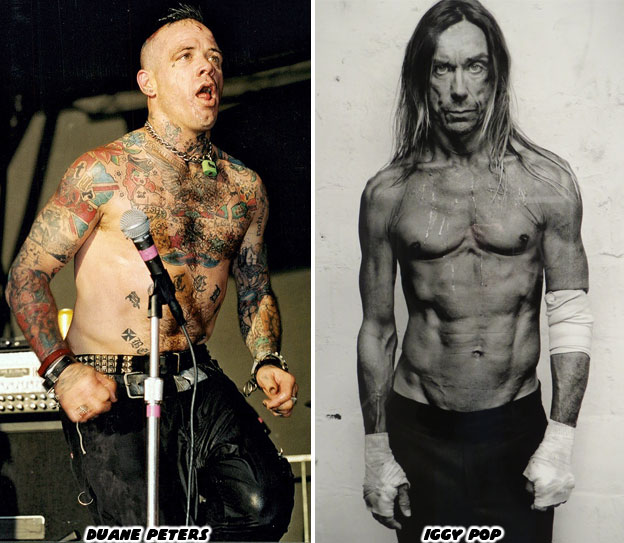
Singer, skateboarder Duane "The Master of Disaster" Peters was into the punk scene from a young age. He was as tough as any long-time punk and had lived a life that would have killed many other people. A veteran of the road he skates as hard as he ever did. He was also born in 1961, during the golden era of skateboarding in Southern California. But let's go even further back. The iconic Iggy Pop also works hard and rocks harder. He was born 1947 and was a catalyst of the punk movement. Iggy has a body better than most men half his age and also shows no sign of slowing down. So when everything about Birdie (up until) now says punk I don't think of fat bikers (which is really what he became). Instead I think of rockers like Iggy and Peters. Birdie should remain as timeless as the other Street Fighter characters. If the developers cannot meet the character with that basic understanding then maybe he shouldn't be in the game.
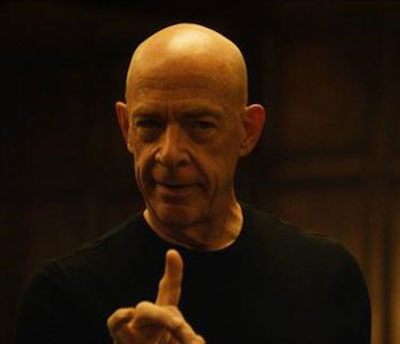
Let's make this perfectly clear. I am not against fat characters in fighting games. I am against silly gimmick characters in franchises that do not need them. Before Birdie got a makeover an even older, and more popular Capcom icon had gotten the same treatment. Mega Man was announced as a playable character for Street Fighter X Tekken. When most people thought of Mega Man they imagined a blue robot that looked like a kid wearing a blaster on his arm and a helmet on his head. What no one could have imagined was a fat guy with a laser pistol and some tights.
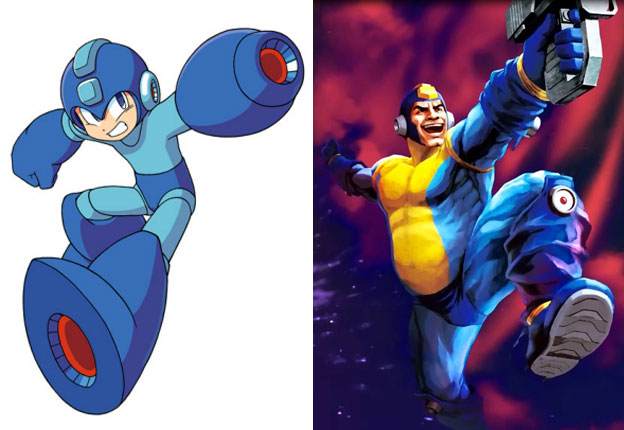
It was an absurd redo of a classic character, one that was based on the poorly designed NES box art from North America. It was more outlandish presentation than say the Bionic Commando as a morose ex-soldier in dreadlocks. Yet somehow somebody at Capcom not only thought this was a good idea, they pushed for it to get done. The artists, animators, programmers and developers all had to model and create this fat guy in a costume and balance him out against the rest of the Street Fighter and Tekken cast. I would assume that it was the producer, Mr. Ono that made the call. Let's go back and look at his short list of questionable decisions in the fighting game arena. He was ultimately responsible for getting Hakan into Street Fighter IV and giving him the silly oiled up attacks. For having T. Hawk sit on opponents and make the Native "how" gesture. For turning El Fuerte from a traditional masked wrestler to a cooking obsessed parody. Of course there was the greatest misstep of all, the addition of Rufus to the Street Fighter universe.
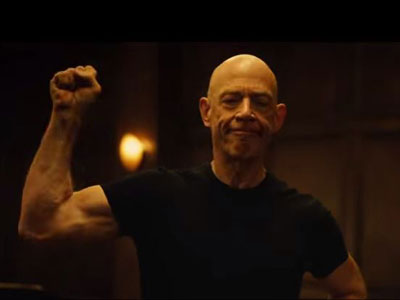
I do not hate fat people in fighting games. I love fat people in fighting games. I love to see diversity in body types, body shapes, skin color, age and ability more than anybody else I know. I love the fact that fat characters have been a part of fighting games since the earliest days. King Hippo in Nintendo's Punch-Out!! and Buchu from Konami's Yie Ar Kung-Fu were two of the earliest fat characters in the genre. The were swift, powerful, had great attacks and distinct looks. Hippo was a likable character and was paralleled in real life by people like super heavyweight boxer Eric "Butterbean" Esch. Capcom had even included fat people in their action games before Street Fighter II debuted.
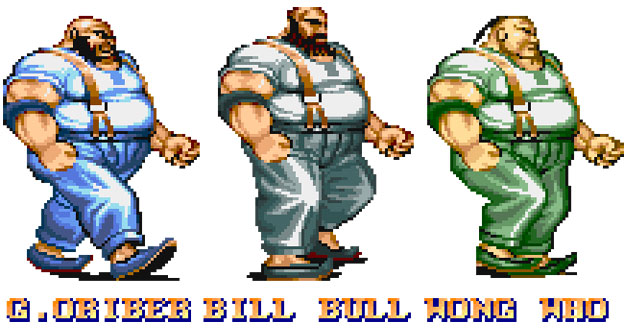
G. Oriber, Bill Bull and Wong Who were members of the Mad Gear Gang. They fought the heroes in Final Fight. The trio, like the rest of the gang, would get beaten up then return for more punishment later on in the stages. The three characters were heavy set but also very muscular. Being nothing more than pallet swaps (simple color changes) with a few cosmetic changes to the heads they were a quick way for the developers to make the cast of villains look numerous. These characters also showed a range of diversity. Oriber and Bull looked Western and Who was presumed to be Chinese. The archetypes were actually inspired by a heavy-set man that used to menace the local bars near Capcom's headquarters in Japan. This added an extra layer of dimension to the brawlers as I could imagine the Capcom employees had to sidestep this person after a night out on the town. I always thought that the fat characters worked well in the series and looked forward to their counterparts in the Final Fight sequels.
The tradition of adding respectable fat fighting game characters was actually observed by several studios and not solely Capcom. Two of the most massive fighters in a fighting game turned out to be eerily similar. Kimala the Bouncer from Capcom's Muscle Bomber / Saturday Night Slam Masters series (1993) and Burnov from SNK's Double Dragon (1995) fighting game were two of fattest game characters ever created. Their arms and legs were often wider than their entire opponents torsos. The two also happened to have Mohawk haircuts to add to their already imposing presence. There was nothing playful or silly about the fighters. They were there to brutalize opponents. Kimala was actually the BWA (Blood Wrestling Association) Heavyweight Champ. Burnov was a post-apocalyptic warlord, not far removed from the villains in Hokuto No Ken / the Fist of the North Star manga series.
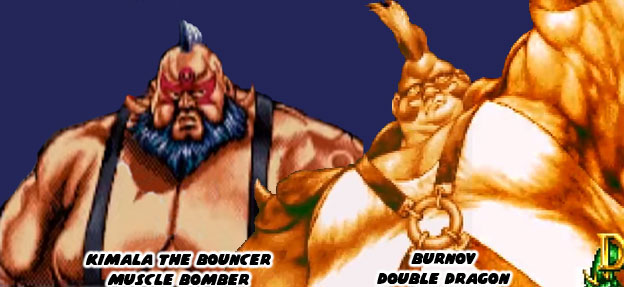
Speaking of which, Hokuto No Ken was a very influential manga series from the early '80s. It colored the development of many fighting games. One of the evil warlords from the comics was called King Heart. He was tall and fat, with deep scars on his forehead. He also had a distinct tattoo on the side of his head. It was a heart with a K for King, modeled after the classic Bicycle company playing cards. The heart tattoo placed on the head of Birdie as a nod to the character. Despite dying a gruesome death in the comics King Heart turned up in a few fighting games, including an arcade version.
Hokuto No Ken series creator Tetsuo Hara was actually a fan of the Street Fighter series and was called in to help with character designs for the wrestling game Muscle Bomber. He created a lineup that was in almost every way as unique as the original World Warriors from Street Fighter II. He modeled Kimala after the Sudanese (actually Canadian) wrestler Larry Robert Shreve, better known by his ring name Abdullah the Butcher. Abdullah was six feet tall and over 350 pounds. He had studied some karate and judo growing up. He found a living through pro wrestling. Abdullah had a very distinct look. He wore red pants with a sash and had curly-toed shoes, a costume that was supposed to bring up images of ancient Arabia. His most defining feature was his forehead. After years of blading (cutting himself to make the matches bloody) his head was left with very deep scars. Abdullah was never much of an athlete so his matches were often standing brawls where he would bring out illegal weapons, like a fork, which he would then use to stab opponents and bust them open so that they bled as well.
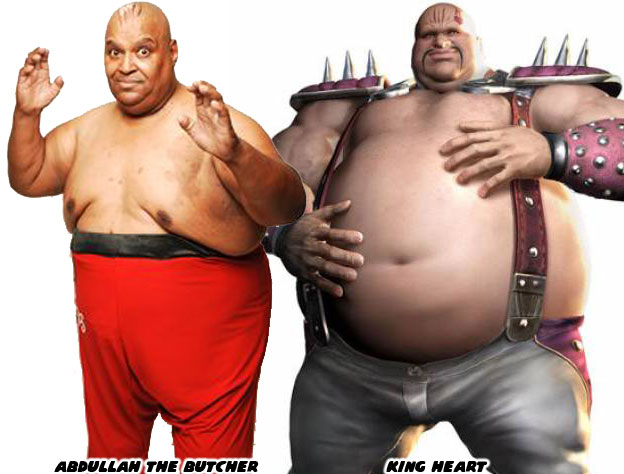
Tetsuo Hara did more than develop fighters, he helped create the backstory for Capcom's wrestling universe. Brutality was what the BWA was known for. The "good guys" wrestled in the CWA or Capcom Wrestling Association. The wrestlers would cross between promotions and have an all-out war trying to find out who was the best wrestler of all. I always admired Kimala as a character and also what Hara was trying to represent through him. The influence that he had on Street Fighter was immeasurable. The boots of Abdullah were paralleled in the curly-toed shoes worn by Birdie. But that was not the only thing that Hara had shaped for the character. Birdie was actually tag team partners with Titan the Great. Titan was the giant of the Muscle Bomber series. He was absolutely massive and just a centimeter or two shorter than Hugo Andore from Final Fight / Street Fighter. In the official character art between Titan and Birdie we could see that Optimus Prime and Megatron from the Transformers were characters on the rings of Birdie. Not only that but Birdie had a Decepticon tattoo on his shoulder. These were details that the people working on Street Fighter V had overlooked or simply did not know.
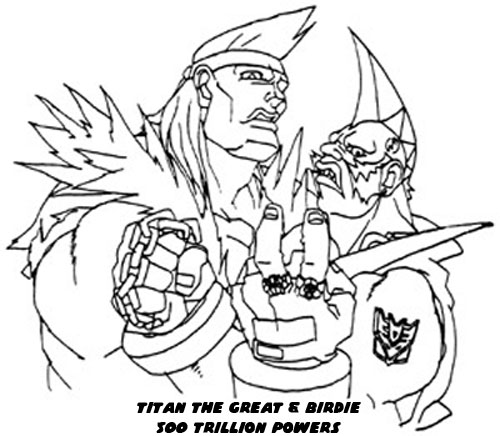
As an aside Abdulah had a hand in influence other fat characters in gaming. The wrestler had been at his craft through the '70s, often touring Japan. There was no doubt that Hara as well as other artists and developers were familiar with the character from his trips. The Middle Eastern look of the Butcher influenced the creation of one of the early console and arcade adventure heroes. Jinborov Karnovski aka Karnov was a fire breathing, ex-circus strongman from East Russia. His red pants, curly-toed boots and heavyweight frame were distinctly Abdullah's. If they were not then he was at least based on old Arabic folklore. The arcade game and NES adaptation of Karnov appeared in 1987. Data East was one of the forefathers of the fighting genre, they had created Karate Champ after all. Instead of focusing on one-on-one combat with fighters of different abilities they instead decided to wrap adventure games around these fighters. Karnov would face fantastic monsters on his journey, similar to a character like Sindbad, the pirate of Arabian legend. In addition to his strength Karnov also had the ability to breath fire. This was an important detail that would shape other characters and games.
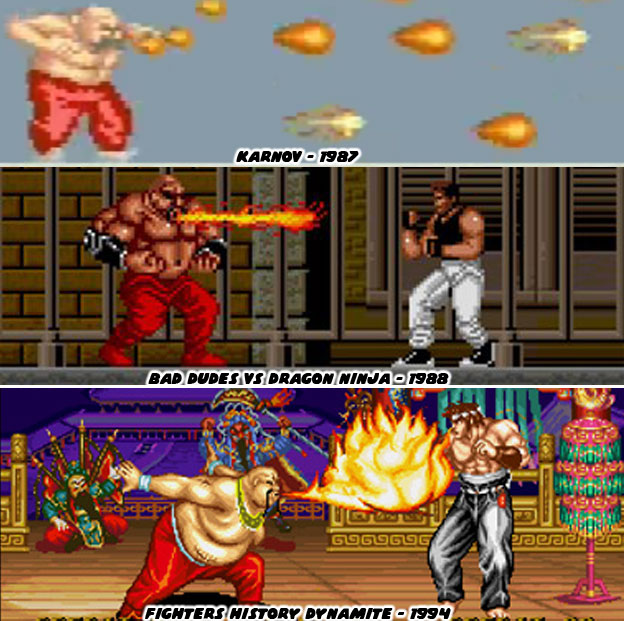
A year after his debut Karnov appeared as the first level boss in the game Bad Dudes vs Dragon Ninja. This appearance meant that Karnov was a modern character but with ancient powers. His adventure was therefor not set in ancient times but instead in a part of the world where mythical creatures and demons existed. Karnov would fall off the radar for a few years. He would return in Fighters History Dynamite: Karnov's Revenge in 1994. Data East could not ignore the runaway success of Street Fighter II in the arcade and on home consoles. The publisher decided to create their own entry. The characters and controls in the original Fighters History were very similar to Street Fighter II. They were so similar in fact that Capcom took Data East to court for copyright infringement. Capcom lost the case and that precedence allowed other studios to create fighting games that also poached ideas from Capcom.
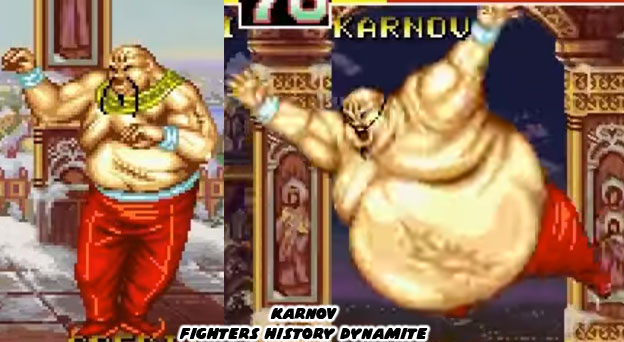
Here's the thing that I want all of my readers to pay attention to. In the original Karnov the character was heavy-set and each time he returned he became a bit fatter. This evolution of the character made sense in continuity. His ability to breathe fire, and his newfound ability to make himself a large balloon were based on ancient magic rather than martial techniques. It also made sense based on the origins of his look and powers. The costume that Abdullah the Butcher wore, the same costume of Karnov was based on ancient Arabia. In the classic story traditions of One Thousand and One Nights, Ali Baba and the Forty Thieves and the Seven Voyages of Sinbad there was a certain body type that kept turning up.
The fat characters were the strongest figures in the stories. Remember that thousands of years ago there were no such things as gyms or weight training programs. Big characters, fat characters, were universally understood as being the strong ones. Also fat characters could sometimes be seen as having status in society because they could afford to eat well. Fighters from these legends sometimes had magical properties. They had to have superhuman strength, be able to breath fire, and run across the sky in order to battle against the mythological characters. Sometimes these mythological characters could partner with them. Djinn or genie's could be summoned by the heroes. The would do this when they needed visit far off lands or destroy their enemies. These classic archetypes were actually featured in the game Arabian Magic by Taito in 1992.
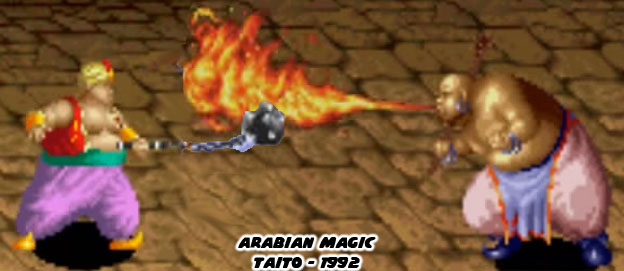
Heroes and villains in Arabian Magic could actually be fat fighters. They were not silly and they did not have some sort of gimmick (like eating bananas and donuts) in order to make them more interesting. Abdullah the Butcher would probably have fit into one of the old stories and definitely would have worked in the games as well. This is where the genius of Hara came into play. Not only was he a huge fan of pro wrestling, he was also very familiar with the classic storytelling traditions. Kimala was influenced by Abdullah but he maintained some of the special abilities from myth. The character could spit poison (a trick used by the Graet Mutah) or breath fire as well. This was a tradition that SNK was familiar with. They used it when they created Burnov. The character could breathe fire and even engulf himself in flames and run over opponents. If you study the costume of Burnov you can see how it was a modernized version of the ancient Arabian costumes.
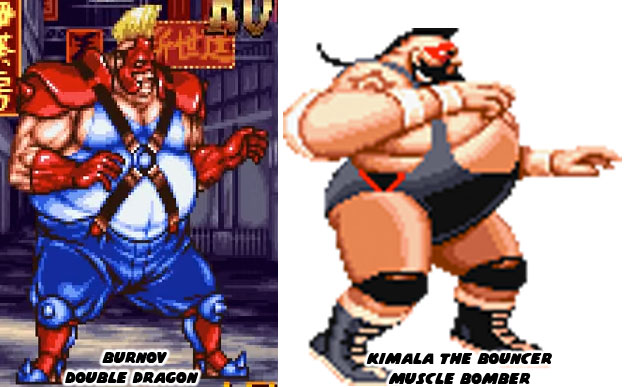
These fat characters were well designed and demonstrated that those body types could work in a fighting game as well. It turned out that characters like Kimala and Karnov were actually the exception instead of the rule. In the next blog we shall take an even closer look at fat characters in the fighting genre and see how the industry changed the purpose of those figures. I hope to see you in the next entry. Please leave any questions or comments if you'd like. As always if you enjoyed this blog and would like to sponsor me please visit my Patreon page and consider donating each month, even as little as $1 would help make better blogs and even podcasts!

Singer, skateboarder Duane "The Master of Disaster" Peters was into the punk scene from a young age. He was as tough as any long-time punk and had lived a life that would have killed many other people. A veteran of the road he skates as hard as he ever did. He was also born in 1961, during the golden era of skateboarding in Southern California. But let's go even further back. The iconic Iggy Pop also works hard and rocks harder. He was born 1947 and was a catalyst of the punk movement. Iggy has a body better than most men half his age and also shows no sign of slowing down. So when everything about Birdie (up until) now says punk I don't think of fat bikers (which is really what he became). Instead I think of rockers like Iggy and Peters. Birdie should remain as timeless as the other Street Fighter characters. If the developers cannot meet the character with that basic understanding then maybe he shouldn't be in the game.
So are you against fat characters in fighting games?

No.
Let's make this perfectly clear. I am not against fat characters in fighting games. I am against silly gimmick characters in franchises that do not need them. Before Birdie got a makeover an even older, and more popular Capcom icon had gotten the same treatment. Mega Man was announced as a playable character for Street Fighter X Tekken. When most people thought of Mega Man they imagined a blue robot that looked like a kid wearing a blaster on his arm and a helmet on his head. What no one could have imagined was a fat guy with a laser pistol and some tights.

It was an absurd redo of a classic character, one that was based on the poorly designed NES box art from North America. It was more outlandish presentation than say the Bionic Commando as a morose ex-soldier in dreadlocks. Yet somehow somebody at Capcom not only thought this was a good idea, they pushed for it to get done. The artists, animators, programmers and developers all had to model and create this fat guy in a costume and balance him out against the rest of the Street Fighter and Tekken cast. I would assume that it was the producer, Mr. Ono that made the call. Let's go back and look at his short list of questionable decisions in the fighting game arena. He was ultimately responsible for getting Hakan into Street Fighter IV and giving him the silly oiled up attacks. For having T. Hawk sit on opponents and make the Native "how" gesture. For turning El Fuerte from a traditional masked wrestler to a cooking obsessed parody. Of course there was the greatest misstep of all, the addition of Rufus to the Street Fighter universe.
A-ha! I knew it, you do hate fat people in fighting games!

Pay attention because I do not want to repeat myself.
I do not hate fat people in fighting games. I love fat people in fighting games. I love to see diversity in body types, body shapes, skin color, age and ability more than anybody else I know. I love the fact that fat characters have been a part of fighting games since the earliest days. King Hippo in Nintendo's Punch-Out!! and Buchu from Konami's Yie Ar Kung-Fu were two of the earliest fat characters in the genre. The were swift, powerful, had great attacks and distinct looks. Hippo was a likable character and was paralleled in real life by people like super heavyweight boxer Eric "Butterbean" Esch. Capcom had even included fat people in their action games before Street Fighter II debuted.

G. Oriber, Bill Bull and Wong Who were members of the Mad Gear Gang. They fought the heroes in Final Fight. The trio, like the rest of the gang, would get beaten up then return for more punishment later on in the stages. The three characters were heavy set but also very muscular. Being nothing more than pallet swaps (simple color changes) with a few cosmetic changes to the heads they were a quick way for the developers to make the cast of villains look numerous. These characters also showed a range of diversity. Oriber and Bull looked Western and Who was presumed to be Chinese. The archetypes were actually inspired by a heavy-set man that used to menace the local bars near Capcom's headquarters in Japan. This added an extra layer of dimension to the brawlers as I could imagine the Capcom employees had to sidestep this person after a night out on the town. I always thought that the fat characters worked well in the series and looked forward to their counterparts in the Final Fight sequels.
The tradition of adding respectable fat fighting game characters was actually observed by several studios and not solely Capcom. Two of the most massive fighters in a fighting game turned out to be eerily similar. Kimala the Bouncer from Capcom's Muscle Bomber / Saturday Night Slam Masters series (1993) and Burnov from SNK's Double Dragon (1995) fighting game were two of fattest game characters ever created. Their arms and legs were often wider than their entire opponents torsos. The two also happened to have Mohawk haircuts to add to their already imposing presence. There was nothing playful or silly about the fighters. They were there to brutalize opponents. Kimala was actually the BWA (Blood Wrestling Association) Heavyweight Champ. Burnov was a post-apocalyptic warlord, not far removed from the villains in Hokuto No Ken / the Fist of the North Star manga series.

Speaking of which, Hokuto No Ken was a very influential manga series from the early '80s. It colored the development of many fighting games. One of the evil warlords from the comics was called King Heart. He was tall and fat, with deep scars on his forehead. He also had a distinct tattoo on the side of his head. It was a heart with a K for King, modeled after the classic Bicycle company playing cards. The heart tattoo placed on the head of Birdie as a nod to the character. Despite dying a gruesome death in the comics King Heart turned up in a few fighting games, including an arcade version.
Hokuto No Ken series creator Tetsuo Hara was actually a fan of the Street Fighter series and was called in to help with character designs for the wrestling game Muscle Bomber. He created a lineup that was in almost every way as unique as the original World Warriors from Street Fighter II. He modeled Kimala after the Sudanese (actually Canadian) wrestler Larry Robert Shreve, better known by his ring name Abdullah the Butcher. Abdullah was six feet tall and over 350 pounds. He had studied some karate and judo growing up. He found a living through pro wrestling. Abdullah had a very distinct look. He wore red pants with a sash and had curly-toed shoes, a costume that was supposed to bring up images of ancient Arabia. His most defining feature was his forehead. After years of blading (cutting himself to make the matches bloody) his head was left with very deep scars. Abdullah was never much of an athlete so his matches were often standing brawls where he would bring out illegal weapons, like a fork, which he would then use to stab opponents and bust them open so that they bled as well.

Tetsuo Hara did more than develop fighters, he helped create the backstory for Capcom's wrestling universe. Brutality was what the BWA was known for. The "good guys" wrestled in the CWA or Capcom Wrestling Association. The wrestlers would cross between promotions and have an all-out war trying to find out who was the best wrestler of all. I always admired Kimala as a character and also what Hara was trying to represent through him. The influence that he had on Street Fighter was immeasurable. The boots of Abdullah were paralleled in the curly-toed shoes worn by Birdie. But that was not the only thing that Hara had shaped for the character. Birdie was actually tag team partners with Titan the Great. Titan was the giant of the Muscle Bomber series. He was absolutely massive and just a centimeter or two shorter than Hugo Andore from Final Fight / Street Fighter. In the official character art between Titan and Birdie we could see that Optimus Prime and Megatron from the Transformers were characters on the rings of Birdie. Not only that but Birdie had a Decepticon tattoo on his shoulder. These were details that the people working on Street Fighter V had overlooked or simply did not know.

As an aside Abdulah had a hand in influence other fat characters in gaming. The wrestler had been at his craft through the '70s, often touring Japan. There was no doubt that Hara as well as other artists and developers were familiar with the character from his trips. The Middle Eastern look of the Butcher influenced the creation of one of the early console and arcade adventure heroes. Jinborov Karnovski aka Karnov was a fire breathing, ex-circus strongman from East Russia. His red pants, curly-toed boots and heavyweight frame were distinctly Abdullah's. If they were not then he was at least based on old Arabic folklore. The arcade game and NES adaptation of Karnov appeared in 1987. Data East was one of the forefathers of the fighting genre, they had created Karate Champ after all. Instead of focusing on one-on-one combat with fighters of different abilities they instead decided to wrap adventure games around these fighters. Karnov would face fantastic monsters on his journey, similar to a character like Sindbad, the pirate of Arabian legend. In addition to his strength Karnov also had the ability to breath fire. This was an important detail that would shape other characters and games.

A year after his debut Karnov appeared as the first level boss in the game Bad Dudes vs Dragon Ninja. This appearance meant that Karnov was a modern character but with ancient powers. His adventure was therefor not set in ancient times but instead in a part of the world where mythical creatures and demons existed. Karnov would fall off the radar for a few years. He would return in Fighters History Dynamite: Karnov's Revenge in 1994. Data East could not ignore the runaway success of Street Fighter II in the arcade and on home consoles. The publisher decided to create their own entry. The characters and controls in the original Fighters History were very similar to Street Fighter II. They were so similar in fact that Capcom took Data East to court for copyright infringement. Capcom lost the case and that precedence allowed other studios to create fighting games that also poached ideas from Capcom.

Here's the thing that I want all of my readers to pay attention to. In the original Karnov the character was heavy-set and each time he returned he became a bit fatter. This evolution of the character made sense in continuity. His ability to breathe fire, and his newfound ability to make himself a large balloon were based on ancient magic rather than martial techniques. It also made sense based on the origins of his look and powers. The costume that Abdullah the Butcher wore, the same costume of Karnov was based on ancient Arabia. In the classic story traditions of One Thousand and One Nights, Ali Baba and the Forty Thieves and the Seven Voyages of Sinbad there was a certain body type that kept turning up.
The fat characters were the strongest figures in the stories. Remember that thousands of years ago there were no such things as gyms or weight training programs. Big characters, fat characters, were universally understood as being the strong ones. Also fat characters could sometimes be seen as having status in society because they could afford to eat well. Fighters from these legends sometimes had magical properties. They had to have superhuman strength, be able to breath fire, and run across the sky in order to battle against the mythological characters. Sometimes these mythological characters could partner with them. Djinn or genie's could be summoned by the heroes. The would do this when they needed visit far off lands or destroy their enemies. These classic archetypes were actually featured in the game Arabian Magic by Taito in 1992.

Heroes and villains in Arabian Magic could actually be fat fighters. They were not silly and they did not have some sort of gimmick (like eating bananas and donuts) in order to make them more interesting. Abdullah the Butcher would probably have fit into one of the old stories and definitely would have worked in the games as well. This is where the genius of Hara came into play. Not only was he a huge fan of pro wrestling, he was also very familiar with the classic storytelling traditions. Kimala was influenced by Abdullah but he maintained some of the special abilities from myth. The character could spit poison (a trick used by the Graet Mutah) or breath fire as well. This was a tradition that SNK was familiar with. They used it when they created Burnov. The character could breathe fire and even engulf himself in flames and run over opponents. If you study the costume of Burnov you can see how it was a modernized version of the ancient Arabian costumes.

These fat characters were well designed and demonstrated that those body types could work in a fighting game as well. It turned out that characters like Kimala and Karnov were actually the exception instead of the rule. In the next blog we shall take an even closer look at fat characters in the fighting genre and see how the industry changed the purpose of those figures. I hope to see you in the next entry. Please leave any questions or comments if you'd like. As always if you enjoyed this blog and would like to sponsor me please visit my Patreon page and consider donating each month, even as little as $1 would help make better blogs and even podcasts!

No comments:
Post a Comment